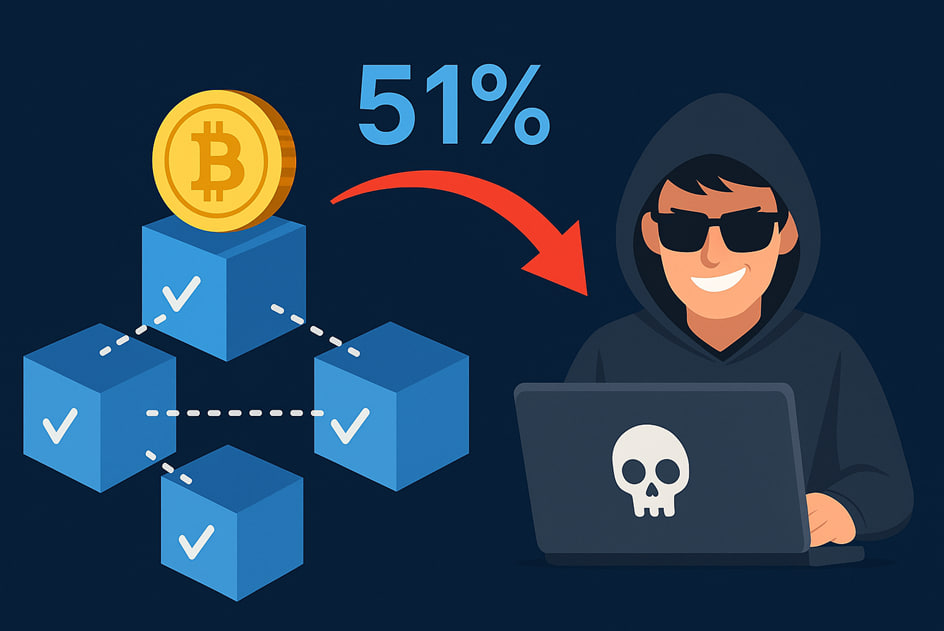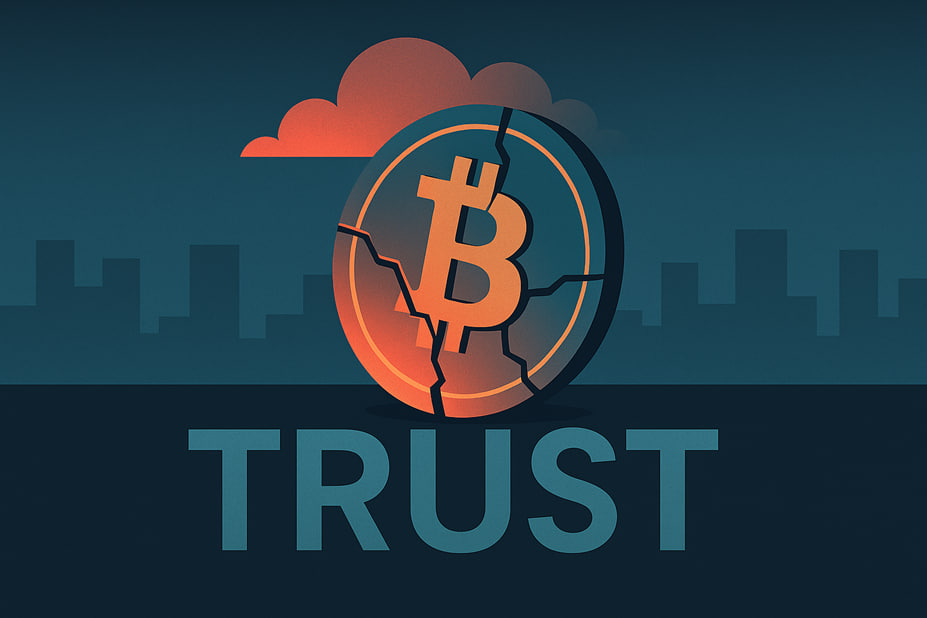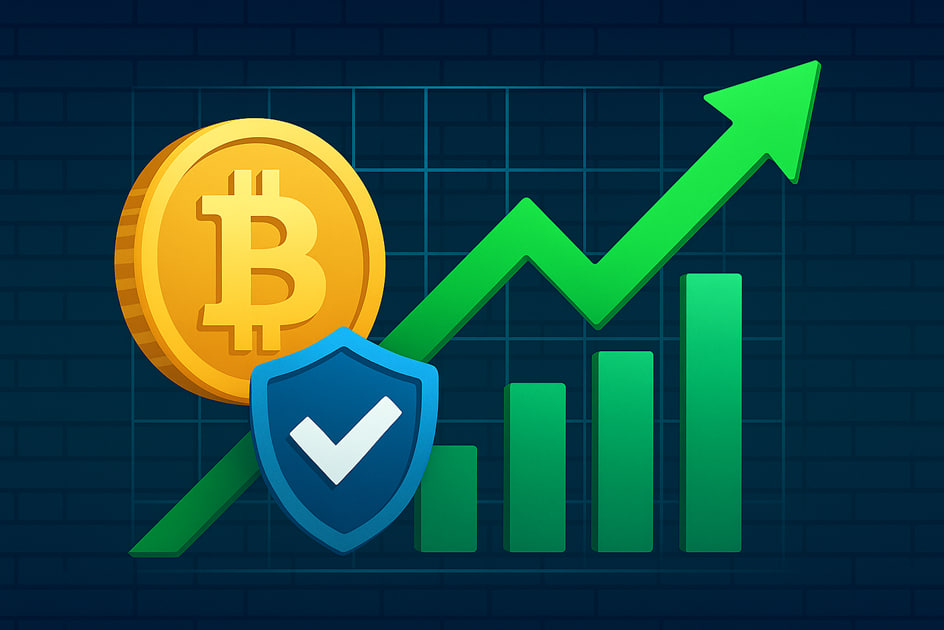51% Attack: Method and Network Risks

Contents
- Introduction
- What is a 51% Attack
- How It Works
- Financial Losses
- The Threat to Trust
- Vulnerabilities of Smaller Networks
- Real-World Cases
- Lessons from the Past
- How to Protect Against a 51% Attack
- The Role of the Community
- Short-Term Consequences
- Long-Term Outlook
- Conclusion
Introduction
A 51% attack is a potential threat to blockchain networks based on mining. When discussing blockchain, it’s essential to understand that it’s not just a database. It’s a system where every operation is verified by thousands of computers around the world. But if someone gains control over most of these computers, they can interfere with the network’s operation. This is precisely what is known as a 51% attack.
This is important because cryptocurrency’s value depends on the blockchain’s stability and transparency. If fraud or data tampering is possible, users start to lose trust.
What is a 51% Attack

A 51% attack is when a single person or group gains control over most of a blockchain’s computational power. In networks that use the Proof of Work mechanism, this means capturing more than 50% of the hashrate. They become the dominant force that decides which transactions are added to the blockchain.
Hashrate refers to the total power of all devices participating in mining. If more than half of this power is controlled by one entity, they can verify transactions and choose which ones are included in the chain and which are not. This allows attackers to manipulate the blockchain for their benefit.
The concept of a 51% attack has been described in theory since the earliest blockchain publications. However, it becomes especially relevant for smaller projects with fewer miners and a lower overall hash rate, making such attacks easier to execute.
How It Works
The attack begins when an attacker accumulates a large amount of computational power. This could be their mining farm or a coalition with other miners. Once they control half of the hashrate, they gain authority over creating new blocks.
They can then do the following:
-
Cancel their transactions. For example, they send coins to someone, then create an alternate version of the chain where the coins were never spent.
-
Perform double-spending. They receive a product or service, then “rewind” the chain and reclaim the money.
-
Censor the network. They can ignore other users’ transactions or entire addresses.
-
Slow down the blockchain. For example, delay block creation or block other miners’ operations.
This completely undermines the integrity and resilience of the blockchain. Users cannot be sure their transfers will be permanent, so the network loses trust and value.
Financial Losses
A 51% attack can directly impact users’ finances. Imagine you send cryptocurrency to someone, only to find the transaction disappeared. Having gained network control, the attacker could roll back the blocks and reclaim the funds. You lose your money, while they keep both the coins and the product.
These actions undermine the very essence of cryptocurrency. If transactions aren’t final, users fear transferring funds. Demand drops, and with it, the coin’s price. Major players exit their positions, and panic intensifies.
It’s important to understand that not only can technical attacks destroy projects. Even without network control, the crypto market faces another serious risk: scams.
Projects posing as promising ventures may be designed from the start to steal investors’ money. These may include fake tokens, bogus teams, forged technical whitepapers, or false partnerships.
The Threat to Trust

When a network succumbs to a 51% attack, it’s not just wallet balances that suffer. Most importantly, trust is lost. People begin to wonder: can this coin even be used at all? If an attacker can reverse transactions, what’s the point of that cryptocurrency?
Investors quickly abandon projects with questionable security, developers don’t want to build on an unreliable foundation, and newcomers choose other networks with lower risks.
Moreover, the idea of decentralization is lost. Blockchain was designed as a system without a single point of control. But if one participant controls over half the network, that becomes the centre, defeating the whole purpose of the technology.
Vulnerabilities of Smaller Networks
The smaller the network, the easier it is to attack. There are fewer miners in small projects, resulting in a lower overall hash rate. To control half the power, an attacker needs less equipment and money.
A 51% attack would require massive resources in large networks like Bitcoin, but it’s much easier for smaller coins. Sometimes, these attacks happen. Users lose funds, the project gains a bad reputation, and people stop using it.
Small networks may be interesting and valuable, but they remain at risk until they attract enough participants. To avoid issues, developers often switch to other protection mechanisms, like Proof of Stake, which works differently.
Real-World Cases
51% attacks are not uncommon in the crypto world. They have occurred with various projects and caused major problems.
Year | Cryptocurrency | Losses | Consequences |
2019 | Over $1 million | A series of double-spending attacks. Exchanges suspended operations, and the price fell sharply | |
2018 | Around $18 million | Coin was delisted from several exchanges, and project trust declined | |
2018 | Over $500,000 | Several double-spend attacks, significant reputational damage |
These cases showed how vulnerable blockchains with low hashrate can be. Even coins with large market caps can suffer if network security isn’t well-maintained.
Lessons from the Past
After the attacks, developers began taking action. They strengthened security and revised how their blockchains operated. Some projects implemented new protocols, increased confirmation thresholds, or transitioned to new algorithms.
These events influenced the entire market. Blockchain projects began paying more attention to decentralization, code auditing, and protection against attacks. This helped improve the resilience of many networks.
How to Protect Against a 51% Attack

To reduce the risk, a project must be planned. Several technical solutions make such attacks nearly impossible:
-
Increasing hashrate. The higher the network’s total computational power, the harder it is to seize control.
-
Switching algorithms. For example, Proof of Stake, where attackers risk their coins.
-
Decentralizing mining. When power is distributed among many participants, an attack becomes less likely.
These steps don’t offer full guarantees, but they make the attack so costly and complex that it loses its appeal.
The Role of the Community
Technical protection is essential, but it alone won’t save the network. Stability also depends on the community. If users stay alert, notice suspicious activity, and respond quickly, an attack can be stopped before it causes harm.
The network becomes stronger when developers actively maintain the project and users stay engaged. Without a vibrant community, any technology gradually loses its defense. It’s this collective effort that keeps the blockchain secure.
Short-Term Consequences
A 51% attack almost always triggers a sharp market reaction. As soon as news of a network takeover spreads, panic begins. People rush to sell their coins to avoid holding an untrustworthy asset.
This leads to volatility—the price drops and the project’s market cap. Exchanges may pause trading or disable withdrawals. Users lose access to their funds, and anxiety grows.
Long-Term Outlook

While an attack causes immediate damage, it can push the industry toward improvement over time. Developers begin paying more attention to security, and new projects incorporate safeguards from the outset.
Trends that became popular after such incidents include:
-
Abandoning algorithms that are easy to exploit
-
Moving to more resilient models like Proof of Stake
-
Growing interest in mining decentralization
-
Creating tools to monitor network health
These attacks also change investor behavior. People increasingly choose networks with transparent structures, active communities, and clear security models.
Conclusion
A 51% attack isn’t just a technical problem. It can affect thousands of users, impact the market, and destroy trust in an entire project. Understanding these risks helps people make informed decisions and avoid vulnerable situations.
To reduce the chance of attack, it’s important to choose networks with strong reputations, stable hash rates, and active communities. Equally important is keeping an eye on updates and not ignoring warning signs in blockchain performance.
Cryptocurrency means freedom, but with it comes responsibility. Security starts not only with code but also with the vigilance of every participant.